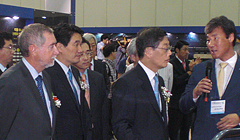NEA Director-General high-level visit to Korea

From 30 August to 3 September, NEA Director-General Luis E. Echávarri was in the Republic of Korea for a series of high-level visits. On 30 August, he participated in the opening of the Nuclear Science and Technology Festival with the Korean Prime Minister, Hwang-Sik Kim. He thanked the Prime Minister for Korea's active participation in the NEA, highlighting the country's achievements in nuclear science and research, and commending the government for having established the new independent regulatory authority. In subsequent discussions, he recalled the importance of having a technically competent, independent nuclear regulatory body that provides factual information in a timely and transparent manner to all interested parties, including the public. On 31 August, Mr. Echávarri provided the opening speech at the Nuclear Science and Technology Forum and gave a lecture to around 100 of Korea's top undergraduates in nuclear studies. Meetings were held with the Korea Atomic Energy Research Institute (KAERI), the Korea Institute of Nuclear Safety (KINS), the Ministry of Education, Science and Technology (MEST) and the Nuclear Safety and Security Commission (NSSC).
New publicationsJANIS 3.4, a Java-based nuclear data display program |
||||
Medical radioisotopesNEA releases medical isotope supply update The NEA has released A Supply and Demand Update of the Medical Radioisotope Market: 2012. Medical radioisotopes such as technetium-99m (99mTc) are used in over 30 million medical examinations worldwide each year so disruptions in the supply chain of molybdenum-99 (99Mo, which is used to produce 99mTc) can lead to cancellations or delays in important medical testing services. This update revises previous NEA supply and demand scenarios based on new data and low enriched uranium target conversion commitments from the supply chain. The update does not present a more optimistic future scenario than previous presentations – concerns about the uneconomic situation of the supply chain continue to dominate the outlook for new projects. This results in the potential for long-term shortages within the decade. However, there are a number of projects that are in various stages of development. If the economics were to change and some of these projects proceed, the long-term supply of 99Mo/99mTc should be reliable. This highlights the need to implement the policy approach developed by the NEA High-level Group on the Security of Supply of Medical Radioisotopes (HLG-MR). Further information on medical radioisotopes can also be found on the NEA website. Medical radioisotope discussion paper: unbundling reimbursement rates to support full-cost recovery At the beginning of August, the NEA released a discussion document entitled "Unbundling payments for radioisotopes from radiopharmaceuticals and from diagnostic procedures: A tool to support the implementation of full-cost recovery". This document provides a basis for further discussions on the use of separate isotope reimbursement to encourage the industry to move to full-cost recovery – an essential step towards long-term sustainability. Separate isotope reimbursement is one tool that could be used by public and private health insurance to help ensure sufficient reimbursement (or payments) for molybdenum-99/technetium-99m as the industry moves to full-cost recovery for irradiation services, pays for outage reserve capacity and transitions to production methods not involving highly enriched uranium. This discussion document is available here. |
 |
|||
Nuclear developmentNEA and IAEA Uranium Group meets to prepare for 2013 Red Book The joint OECD/NEA and IAEA Uranium Group met on 21-22 August in Kirovograd, Ukraine, to begin preparations for the publication of the 2013 Red Book (Uranium 2013: Resources, Production and Demand). With continuing interest in uranium production and demand, 44 participants from 24 countries and the Euratom Supply Agency took part in this meeting, completing the questionnaire content and agreeing on the timing of data collection for the next edition, which will be the 25th in the Red Book series. Kirovograd is situated in the heart of the uranium mining area in Ukraine, and participants were welcomed by the Governor who highlighted the importance of the industry to the regional economy. Before and after the meeting, Uranium Group members were able to take part in tours of the region's uranium mining and milling facilities and the South Ukraine nuclear power plant. |
 |
|||
Nuclear lawInternational School of Nuclear Law Participants from 30 countries and international organisations have recently concluded their study at the 12th session of the International School of Nuclear Law (ISNL), a two-week programme conducted by the NEA in co-operation with the University of Montpellier 1, France. The ISNL provides participants with a comprehensive course on the legal issues relating to the safe, efficient and secure use of nuclear energy. Renowned specialists from international organisations, governments and industry lecture on law and related technical aspects of the nuclear power sector. The course has evolved over the years to address new challenges in the field. This year, a panel of experts led a discussion on the implications of the Fukushima Daiichi accident for nuclear regulation, radiological protection and third party liability regimes. To date, the ISNL has hosted 650 graduate students and professionals. The next session of the ISNL will commence in late August 2013. |
 |
|||
MDEPUnited Arab Emirates' nuclear regulator joins the MDEP On 20 August, the United Arab Emirates (UAE) Federal Authority for Nuclear Regulation (FANR) became an associate member of the Multinational Design Evaluation Programme (MDEP). Associate membership is intended for national regulatory authorities of qualified countries that have made firm commitments to undertake safety licensing reviews of designs that are under review by other MDEP regulators. The FANR is due to participate in its first meeting on 24-26 September, when the MDEP Steering Technical Committee (STC) meets in Beijing, China. More information on the MDEP can be found on the NEA website. |
||||
Data BankComputer program services New computer programs available
|
||||
The monthly bulletin only lists new and updated material. It is distributed by e-mail to registered users of the Nuclear Energy Agency's Online Services. Registration is free; please use this link. |